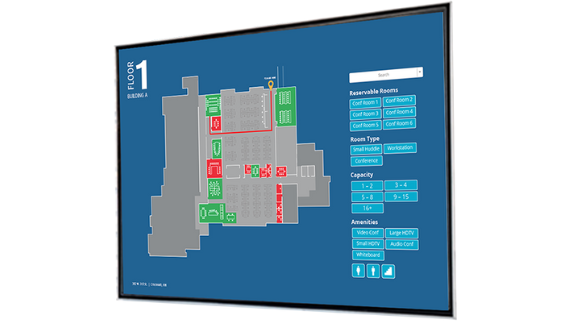If you've ever found yourself frantically trying to locate 'Conference Room 3B' for a meeting, or desperately searching for a specific cubicle, you've personally experienced the need for wayfinding.
Wayfinding in the workplace is a practical, facility-based system that supports the smooth navigation of employees, clients, visitors, vendors, and others from one area to another.
While the challenges of navigating massive workspaces are not new, the practical impact on workers and others is amplified as workplaces evolve. Large buildings can benefit from wayfinding even in a traditional setting where all employees are expected to be onsite daily. In a hybrid office model, where some employees work remotely on certain days and in person on others, the potential advantages of implementing wayfinding technology expand exponentially.
Why is wayfinding technology important?
Suppose that employees in your workplace may work from a remote location (such as their home) and one or more company facilities. These workers often do not have an assigned workspace and use a different space whenever they enter the building. Finding the assigned space may be time-consuming if the facility is large. Furthermore, if an employee needs to confer with another hybrid worker, they must track that individual down in another unfamiliar location.
Of course, workplaces are not the only spaces that can effectively use this technology. It is already used in other places, such as transportation hubs, public event facilities, healthcare centers, and educational campuses.
In workplaces, the demand for wayfinding technology is increasing, prompted in part by the growth in office utilization strategies, including hot-desking and hoteling. The advantages of deploying a wayfinding system include:
• Enhancing workplace efficiency and productivity
• Decreasing wasted time and frustration
• Contributing positively to brand image and user satisfaction
• Supporting accessibility for occupants and visitors
Wayfinding offers more than directions to your desk, the meeting room, or a colleague's workspace. Wayfinding systems include an interactive map that gives directions and can also identify and reserve meeting rooms and other shared spaces. A wayfinding reservation system can filter space according to capacity and technology (such as remote access, monitors, and presentation equipment) and then offer directions to the selected space while also updating the availability.
Consider these real-world examples of how a wayfinding system can enhance efficiency and reduce wasted time:
- An employee who typically works from home is working in the office today. They have reserved a cubicle for the day but need to find out where it is. When the worker enters the building, they use the interactive kiosk in the lobby to get step-by-step directions to their workplace and can also find and reserve a conference room as needed.
- A visitor enters the building to meet with employees onsite. The wayfinding system can direct this visitor to the meeting space or instead let them know where to check in for identification and a guest badge.
- The catering vendor arrives with lunch for a senior management meeting and uses the wayfinding system to find the direct route to the lunch location, avoiding the need for an escort.
In each of these common scenarios, a wayfinding system can reduce wasted time and frustration and provide a positive experience for the employee, vendor, or visitor.
Your wayfinding system may incorporate a mobile application that allows users to follow directions as they would using common navigation apps. These systems may also highlight points of interest, such as restrooms, cafeterias, or common areas. The system can include strategically placed monitors that users can consult along the way and may even use the person’s location to produce an efficient route to the destination.
Challenges in effectively using wayfinding
For successful implementation and execution, the workspace must maintain up-to-date floorplans. If the company changes space configurations without appropriate updates to the wayfinding technology, the outcome can be more frustration and wasted time rather than less.
Also, the wayfinding system should integrate transparently with the building’s other workplace technologies, like sensors, employee directories, and visitor management protocols.
Other important uses
Security and Evacuation
Implementing a wayfinding system can significantly improve workplace safety and security. In an emergency evacuation, the system can quickly direct people to the nearest exit and their assembly point. In some applications, it can automatically eliminate access to dangerous areas and even open emergency exits.
The VuBook Solution
AVUITY’s VuBook technology supports space booking and wayfinding with interactive maps and the room display system, available via display panels and the mobile application. Using these tools, workers can identify available seats or appropriate meeting areas, reserve them, and obtain step-by-step directions to the location.
Furthermore, integrating booking and wayfinding systems with other sensor applications can automate heating, cooling, and other environmental adjustments to respond to occupancy and conditions.
Conclusion
In conclusion, wayfinding technology is transforming how we navigate and experience indoor spaces, particularly in the workplace.
In a hybrid work model where employees work remotely and in-office, wayfinding becomes even more crucial to help workers locate their assigned workspace, find colleagues, and reserve shared spaces. This technology empowers employees, giving them the tools they need to navigate their workplace, which can enhance workplace efficiency, lower frustration, and contribute to a positive brand image.
Wayfinding systems can integrate with other technologies like sensors, employee directories, and visitor management protocols, advancing the overall impact of the technology deployment. These systems can also play a crucial role in enhancing safety, directing people to the nearest exit during emergencies, and tracking occupants' locations. Knowing that such a system is in place may enhance a sense of security in the workplace, making it a more comfortable environment for all.
However, effective implementation requires maintaining up-to-date floor plans and addressing privacy concerns around employee tracking. Allowing employees to opt-in to location sharing will help balance productivity and trust.
Overall, wayfinding technology is valuable for creating a more connected, efficient, and user-friendly workplace experience in today's evolving office landscape.
To learn more about implementing a wayfinding solution in your offices, request a demo today.


